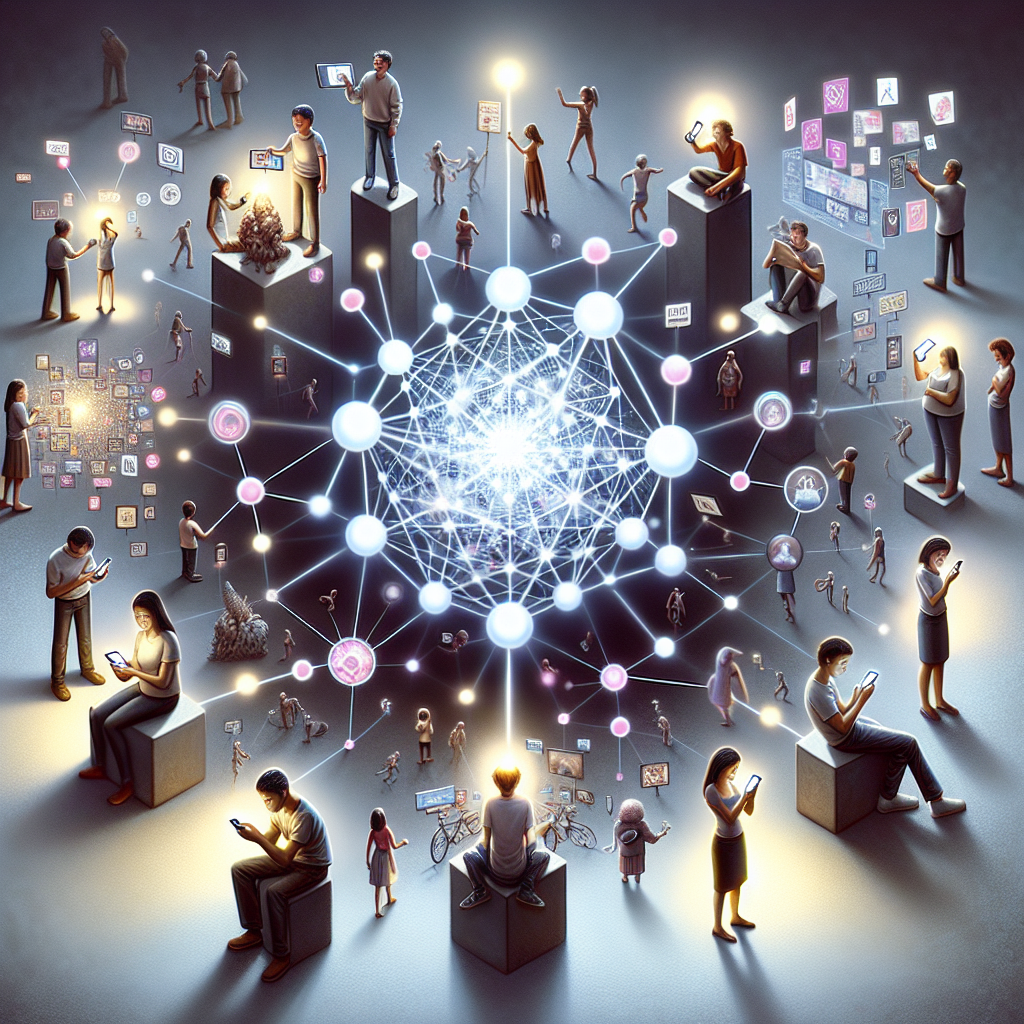-
Table of Contents
“Shaping Realities: The Power and Perils of Social Media Algorithms”
Introduction

The advent of social media has revolutionized the way individuals communicate, share information, and interact with the world. Central to this transformation are the algorithms that govern the content users see on platforms such as Facebook, Twitter, Instagram, and TikTok. These algorithms, designed to enhance user engagement and optimize the user experience, have profound implications for society. They influence not only the type of content that gains visibility but also shape public opinion, cultural trends, and even political landscapes. By prioritizing certain posts over others based on user behavior and preferences, social media algorithms create echo chambers, amplify misinformation, and impact mental health. Understanding the impact of these algorithms is crucial for comprehending the broader effects of social media on contemporary society.
Understanding the Influence of Social Media Algorithms on User Behavior
In the digital age, social media platforms have become an integral part of daily life, shaping how we communicate, consume information, and perceive the world around us. At the heart of these platforms are sophisticated algorithms designed to personalize user experiences. While these algorithms aim to enhance engagement and satisfaction, their influence on user behavior is profound and multifaceted, raising important questions about their broader societal impact.
To begin with, social media algorithms curate content based on user preferences, interactions, and behaviors. By analyzing vast amounts of data, these algorithms predict what content will keep users engaged, thereby increasing the time spent on the platform. This personalized approach can create a more enjoyable and relevant experience for users, as they are more likely to encounter posts, videos, and articles that align with their interests. However, this same mechanism can also lead to the creation of echo chambers, where users are predominantly exposed to viewpoints and information that reinforce their existing beliefs. Consequently, this can contribute to polarization and reduce exposure to diverse perspectives, which are essential for a well-rounded understanding of complex issues.
Moreover, the prioritization of engaging content often means that sensational, emotionally charged, or controversial posts are more likely to be promoted. This can amplify misinformation and fake news, as such content tends to generate higher levels of interaction. The spread of false information can have serious real-world consequences, from influencing public opinion and election outcomes to exacerbating public health crises. While social media companies have implemented measures to combat misinformation, the challenge remains significant due to the sheer volume of content and the sophisticated tactics used by those spreading falsehoods.
Another critical aspect to consider is the impact of social media algorithms on mental health. The constant stream of curated content can create unrealistic standards and foster feelings of inadequacy, particularly among younger users. The pressure to present a perfect life online can lead to anxiety, depression, and other mental health issues. Additionally, the addictive nature of these platforms, driven by algorithmic design, can result in excessive screen time, further exacerbating these problems. It is essential for both users and platform developers to recognize these risks and promote healthier online habits.
Furthermore, the influence of social media algorithms extends to the realm of commerce and consumer behavior. By targeting users with personalized advertisements, these algorithms can drive consumer spending and shape purchasing decisions. While this can be beneficial for businesses and convenient for consumers, it also raises concerns about privacy and data security. The collection and use of personal data for targeted advertising have sparked debates about user consent and the ethical implications of such practices.
In response to these challenges, there is a growing call for greater transparency and accountability from social media companies. Policymakers, researchers, and advocacy groups are urging platforms to provide more insight into how their algorithms operate and to implement safeguards that protect users from harmful content and practices. Additionally, there is a push for digital literacy education to help users better understand and navigate the complexities of the online world.
In conclusion, while social media algorithms have the potential to enhance user experiences and connect people in unprecedented ways, their influence on behavior and society is significant and complex. As we continue to navigate the digital landscape, it is crucial to strike a balance between leveraging the benefits of these technologies and mitigating their potential harms. By fostering a more informed and conscientious approach to social media use, we can work towards a healthier and more inclusive online environment.
The Role of Social Media Algorithms in Shaping Public Opinion
In today’s digital age, social media platforms have become powerful tools for communication, information dissemination, and public discourse. Central to the functioning of these platforms are algorithms, complex sets of rules and calculations that determine what content users see in their feeds. These algorithms, while designed to enhance user experience by personalizing content, have a profound impact on shaping public opinion, often in ways that are not immediately apparent.
To begin with, social media algorithms prioritize content based on user engagement. Posts that receive more likes, shares, and comments are more likely to be promoted, creating a feedback loop that amplifies popular content. This mechanism can lead to the rapid spread of information, both accurate and misleading. For instance, during election cycles or major news events, algorithms can inadvertently prioritize sensational or emotionally charged content, which tends to generate higher engagement. Consequently, users may be exposed to a skewed representation of events, influencing their perceptions and opinions.
Moreover, the personalization aspect of these algorithms means that users are often presented with content that aligns with their existing beliefs and interests. This phenomenon, known as the “filter bubble,” can create echo chambers where individuals are insulated from diverse perspectives. While this can enhance user satisfaction by providing a tailored experience, it also reinforces confirmation bias, making it difficult for users to encounter and consider alternative viewpoints. As a result, public opinion can become polarized, with different groups becoming more entrenched in their views.
In addition to shaping what content is seen, social media algorithms also influence how content is framed. The algorithms take into account various factors such as the user’s past behavior, the behavior of their network, and even the time of day. This means that the same piece of news can be presented differently to different users, subtly shaping their interpretation of the information. For example, a news story about climate change might be framed with an emphasis on scientific consensus for one user, while another user might see the same story framed with a focus on economic implications. These nuanced differences can significantly impact how individuals understand and react to information.
Furthermore, the role of social media algorithms in shaping public opinion extends to the realm of advertising. Political campaigns and interest groups can leverage these algorithms to target specific demographics with tailored messages. This micro-targeting can be highly effective in swaying opinions and mobilizing voters, but it also raises ethical concerns about manipulation and transparency. Users may not be fully aware of how their data is being used to influence their opinions, leading to questions about the integrity of the democratic process.
Despite these challenges, it is important to recognize that social media algorithms are not inherently malevolent. They are designed to enhance user experience and keep people engaged. However, the unintended consequences of their design necessitate a critical examination of their impact on public opinion. As users, we must be aware of the potential biases and limitations of the content we consume. Additionally, there is a growing call for greater transparency and accountability from social media companies in how their algorithms operate.
In conclusion, social media algorithms play a significant role in shaping public opinion by determining what content is seen, how it is framed, and who it reaches. While they offer personalized experiences and can facilitate the rapid spread of information, they also contribute to echo chambers, polarization, and potential manipulation. As society continues to grapple with these issues, it is crucial to foster a more informed and critical approach to consuming content on social media platforms.
How Social Media Algorithms Affect Content Visibility and Engagement
In the digital age, social media platforms have become integral to how we communicate, share information, and engage with the world. At the heart of these platforms are algorithms—complex sets of rules and calculations that determine what content users see. These algorithms are designed to enhance user experience by prioritizing content that is most likely to engage each individual. However, the impact of social media algorithms on content visibility and engagement is a double-edged sword, with both positive and negative consequences.
On one hand, social media algorithms can create a more personalized and engaging experience for users. By analyzing a user’s behavior, preferences, and interactions, these algorithms can curate a feed that is tailored to individual interests. This means that users are more likely to see content that resonates with them, whether it’s posts from close friends, updates from favorite brands, or news articles on topics they care about. Consequently, this personalized approach can lead to higher engagement rates, as users are more inclined to like, comment, and share content that they find relevant and interesting.
However, the same algorithms that enhance user experience can also create echo chambers and filter bubbles. By consistently showing users content that aligns with their existing beliefs and preferences, algorithms can inadvertently reinforce biases and limit exposure to diverse perspectives. This can lead to a more polarized online environment, where users are less likely to encounter differing viewpoints and more likely to engage with content that confirms their preexisting opinions. The implications of this are far-reaching, as it can contribute to the spread of misinformation and deepen societal divisions.
Moreover, the impact of social media algorithms on content visibility can be particularly challenging for content creators and businesses. With algorithms favoring content that generates high engagement, creators are often pressured to produce material that is sensational or emotionally charged to capture attention. This can lead to a focus on quantity over quality, as well as a tendency to prioritize viral content over meaningful or informative posts. For small businesses and new creators, breaking through the algorithmic barriers to reach a wider audience can be an uphill battle, as their content may be overshadowed by more established or sensational accounts.
In addition to these challenges, there is also the issue of algorithmic transparency. Social media platforms often keep the specifics of their algorithms under wraps, making it difficult for users and creators to understand how content is prioritized and why certain posts gain more visibility than others. This lack of transparency can lead to frustration and a sense of powerlessness, as users and creators feel at the mercy of an opaque system that they cannot fully comprehend or control.
Despite these concerns, it is important to recognize that social media algorithms are not inherently good or bad. They are tools that can be used to enhance user experience and engagement, but they also come with inherent risks and challenges. As users, creators, and platform developers, it is crucial to approach these algorithms with a critical eye and a commitment to fostering a more inclusive and balanced online environment.
In conclusion, social media algorithms have a profound impact on content visibility and engagement, shaping the way we interact with digital content. While they offer the potential for a more personalized and engaging experience, they also pose significant challenges, from reinforcing biases to creating barriers for new creators. By striving for greater transparency and a more nuanced understanding of these algorithms, we can work towards a more equitable and informed digital landscape.
Conclusion
The impact of social media algorithms is profound, shaping user experiences and influencing societal dynamics. These algorithms personalize content, enhancing user engagement and satisfaction by curating feeds based on individual preferences and behaviors. However, they also contribute to the creation of echo chambers, reinforcing existing beliefs and potentially fostering polarization. The prioritization of sensational or emotionally charged content can exacerbate misinformation and reduce the quality of public discourse. Additionally, the opaque nature of these algorithms raises concerns about privacy, data security, and the ethical implications of automated decision-making. Overall, while social media algorithms offer significant benefits in terms of personalized content delivery, their broader societal impacts necessitate careful consideration and regulation to mitigate negative consequences.





